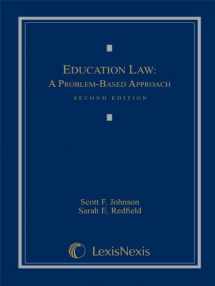
Education Law: A Problem-Based Approach (Loose-leaf version)
ISBN-13:
9780769857664
ISBN-10:
0769857663
Edition:
Second
Author:
Scott F. Johnson, Sarah E. Redfield
Publication date:
2012
Publisher:
LEXISNEXIS
Format:
Ring-bound
942 pages
FREE US shipping
Book details
ISBN-13:
9780769857664
ISBN-10:
0769857663
Edition:
Second
Author:
Scott F. Johnson, Sarah E. Redfield
Publication date:
2012
Publisher:
LEXISNEXIS
Format:
Ring-bound
942 pages
Summary
Education Law: A Problem-Based Approach (Loose-leaf version) (ISBN-13: 9780769857664 and ISBN-10: 0769857663), written by authors
Scott F. Johnson, Sarah E. Redfield, was published by LEXISNEXIS in 2012.
With an overall rating of 4.1 stars, it's a notable title among other
books. You can easily purchase or rent Education Law: A Problem-Based Approach (Loose-leaf version) (Ring-bound) from BooksRun,
along with many other new and used
books
and textbooks.
And, if you're looking to sell your copy, our current buyback offer is $0.49.
Description
This heavily discounted, three-hole punched, alternative loose-leaf version of the hardbound book is printed on 8 ½ x 11 inch paper with wider margins and with the same pagination as the hardbound book. Education Law: A Problem-Based Approach offers a problem based approach to teaching education law. The book covers both the standard education law topics and cutting-edge topics such as the Internet, electronic speech, discipline for off-campus behavior, cyber-bullying, strip searches, and various issues regarding NCLB and education reform. The book also provides a guided, hands-on approach that gives students an opportunity to go outside of the text and gather information about how certain aspects of education law work in ""the real world"" and in their own states. This innovative text starts with an introductory and foundational chapter and then proceeds to cover each topic through a problem-based approach. The text provides a problem and related statutory, regulatory, and court decisions that not only inform students of the relevant law but also provide impetus for students to focus their understanding on real and relevant problems. For example, the opening foundational chapter (which includes Brown, San Antonio, and Plyler, as well as information on the state of education and education reform), asks students to consider a law / litigation-oriented strategy for achieving improvement in the education system as we know it today. Similarly, part of a later chapter on liability offers extensive narrative and then poses a problem on a space-monkey playground game (kids hang upside down on the monkey bars and deliberately try to pass out as if floating in space). To facilitate students' ability to understand and answer the problem, the text offers cases that are decided both ways on analogous facts and negligence. The problems in Education Law: A Problem-Based Approach are all drawn to be current and immediately relevant. The case and statutory and regulatory materials support this approach by including the classic Supreme Court cases such as Brown v. Board of Education, Rowley, T.L.O., and the speech trilogy, along with the recent decisions by the Court such as Safford Unified Sch. Dist. v. Redding, Forest Grove Sch. Dist. v. T.A., and Horne v. Flores. Leading lower court cases are also provided along with various state and federal statutes and regulations. Topics covered in the book include: • Foundational principles (including sources of law, the hierarchy of laws involved, and how state and federal law interact); • School funding; • Employment issues; • Instruction and curricular issues, including academic freedom; • Attendance, assignment, and placement (including compulsory attendance issues and home-schooling issues); • School liability (including torts, Section 1983, Title IX, and online liability); • Privacy rights and right to know (includes FERPA); • Student discipline; • Student expression; • Search, seizure, and interrogation; • Religion; • Special education; and • No Child Left Behind.


We would LOVE it if you could help us and other readers by reviewing the book
Book review

Congratulations! We have received your book review.
{user}
{createdAt}
by {truncated_author}


